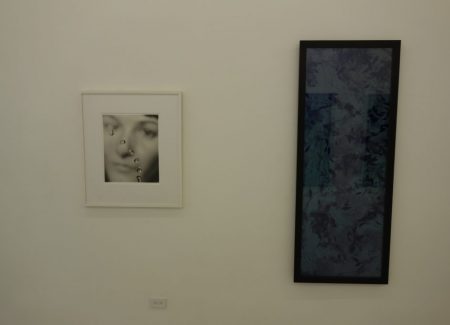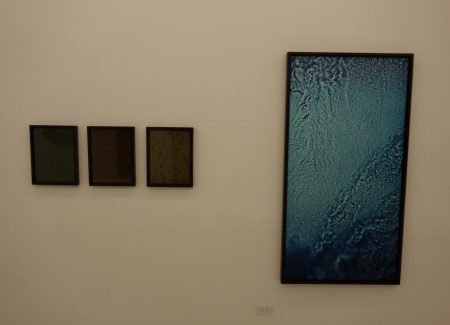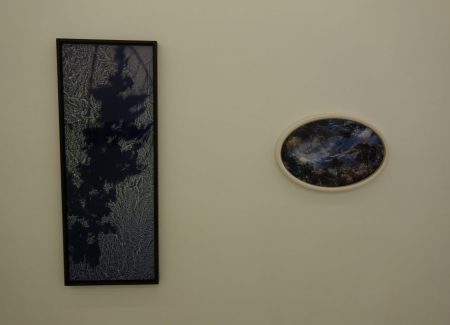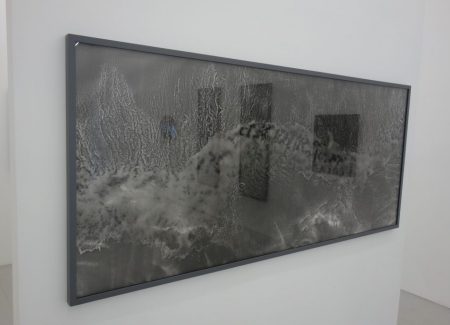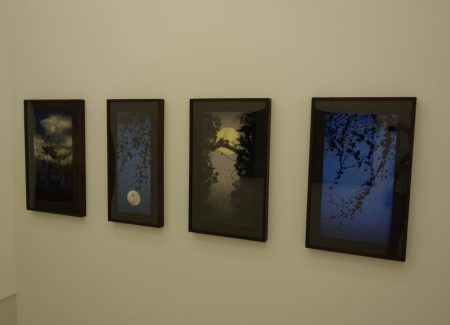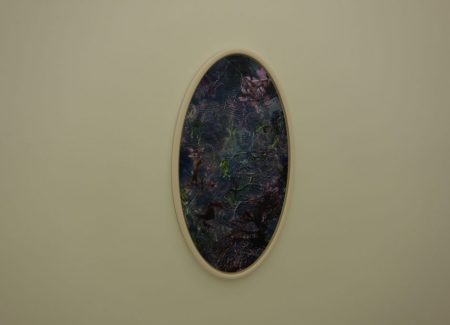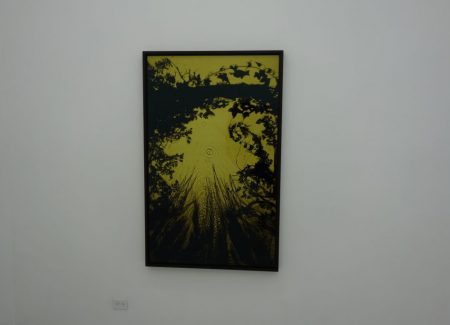JTF (just the facts): A total of 20 color and black-and-white photographs, dating from 1991-2016, and exhibited on both floors of the split-level gallery (18 on top; 2 on bottom). The prints were made in a variety of processes: gelatin silver (1 unique; 1 in an edition of 3); Cibachrome (all 9 are unique); C-print (3 unique); and digital C-Type (6 in editions ranging from 3 to 75). Sizes vary, from roughly 24×14 to 41×91 inches (or reverse). Shapes are either ovals (3) or rectangles (17). (Installation shots below.)
Comments/Context: In 1994, when Susan Derges made her U.S. debut at Danziger with The Observed and the Observed, she seemed like an artist who could move in any one of several directions. A science project and a philosophic statement, the 1991 series was made by vibrating a stream of water and photographing the separate droplets with a strobe. Each image was also a multiple self-portrait with a bi-focal perspective. Derges’ cloudy face loomed in the background behind the mercurial drops. But only after you stepped back, did the blurry contours of her face clarify, and only when you stepped closer did you see that same face reflected and refracted in watery, distorted miniature. The series was part Harold Edgerton, part Cindy Sherman: a playful study in the dynamics of electronic light and an investigation of the self as fluid and many-sided.
The 1996 exhibition Under the Sun at the Fraenkel Gallery grouped her with three other British photographers (Adam Fuss, Christopher Bucklow, and Garry Fabian Miller), and although each has adapted to the digital revolution, their work has generally evolved apart from both the disposable, over-sharing world of social media and the trumpery of Photoshop.
English artists have an easier time than Americans in being out-of-step—it’s even encouraged there—and Derges has over the last 25 years stayed close to home, developing into a rural naturalist. Her particular interest is the medium of water, both as a material for photographic interactions and as a primal incubator of life. Much of her time is spent devising experiments—making long exposures by moonlight, transporting tide pools into her studio—during which she chooses to control only the start of the process. The vagaries of nature do the rest and dictate the final result.
Her three studio-created photograms of frog spawn, Full Circle (1992), trace the animal’s metamorphosis from a reticulated cluster of eggs, to a spatter of tadpoles, and finally into hatched froglets. For her series on the River Taw (1997-99), a tidal river in Devon that empties into the Bristol Channel, she mounted color photographic paper on a rigid aluminum plate and immersed the sheets in the currents at night, making her exposures by flashlight. Most of the photographs were recognizable imprints of leaves, branches; others were amorphous.
She edged decisively toward abstraction in her Shoreline series (1997-98.) The one example in this show—a horizontal black-and-white photogram some 7 ½ ft. wide—is the largest piece here, and was perhaps the most technically demanding to produce. The churning river water that reached the banks, where she dipped and exposed her paper, is translated into a gray mass with bleached holes, not unlike some of the dream-like images in lead by Anselm Kiefer. (Fuss’s vertical black-and-white photograms in his most recent show at Cheim & Read (reviewed here) are studio versions of what Derges did some 15 years ago here.)
Derges trained as a painter in London, then spent 5 years in Japan, and her color photograms are informed by both these influences. Many are monochromatic—she has a fondness for shades of cyan—and poetically allusive rather than starkly descriptive. Photograms do not allow much depth of field so whatever appears on her sheets tends to be flat and cropped. She openly acknowledges her debt to Asian scroll and vase paintings, the post-Impressionism of Whistler, as well as the Pictorialism of Clarence White by printing her images—of the moon or drooping tree branches—as slender rectangles.
Daring though it may be for Derges to be so proudly out-of-fashion and fulsomely decorative, she risks succumbing to a saccharine vision of nature as wholly benign. Her slow, hand-made, one-of-a-kind method further alienates her from our era of post-modern image production.
Happily, two of her most recent works—examples from her Tide Pool series (2015-)—exhibit a more adventurous color palette and less of a fin-de-siècle deliquescence. Both are small flattened ovals and their egg shapes add another layer of meaning to the subject of the rocky nests where naturalists tell us life on land began. Tide Pool 32 (2015) is a reflection of clouds in water, their outlines unstable, like a Baroque sky. Tide Pool 39 (2105) is one of the most beautiful pictures she has ever made: tendrils of dark green kelp and seaweed sway from every edge, into a center that is violet-blue and twisted with wispy reflections of cloud. She has bounced light off the surface so that dark ripples of water are visible on the top of several layers, and the print as a whole has a hard enamel-like polish. Rectangular examples from the series that I’ve seen online are equally complex. The ovals though have special advantages. They’re less like pictures on a wall than fabulous view through the portholes of a submarine, or snow globes of controlled chaos. For the first time since The Observer and the Observed, I am eager to follow where Derges is going.
Collector’s POV: Nearly half of this show is sold or on hold. The remaining works are priced between $1200 (for Gibbous Moon Alder, printed in an edition of 75) and $26000 (for River Taw, a unique Cibachrome.) Derges’ work can be intermittently found at auction; recent prices have ranged between $3000 and $29000.
